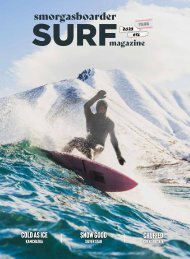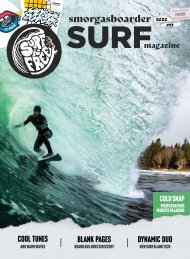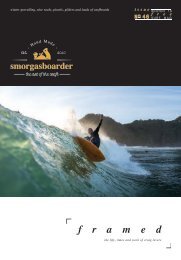SB_issue55_Digital
Create successful ePaper yourself
Turn your PDF publications into a flip-book with our unique Google optimized e-Paper software.
The Foil Drive essentially allows you to<br />
move at twice the paddle speed.<br />
“There is still someways to go I believe<br />
in terms of bringing down the price but<br />
at $5,500 for the motorised Foil Drive<br />
propellor plus say $1500 for a board it is<br />
significantly cheaper than a motorised<br />
Flightboard that will cost you anything<br />
from $14,000 through to $18,000. I see<br />
this advancement in the technology as<br />
opening up more avenues for people<br />
to get into foiling. We believe there<br />
will be improved assist systems as<br />
more people discover the joy of riding<br />
uncrowded swells.”<br />
As Jack explains it, learning to ride a foil<br />
is not dissimilar to riding a bike. Once<br />
you have the hang of it and have done<br />
it a few times, muscle memory takes<br />
over. It is training your muscles in the<br />
first instance that just takes a little time,<br />
which is made all the more difficult by<br />
the challenge of firstly getting the board<br />
up on foil.<br />
“That’s the real challenge, getting the<br />
board on foil initially. You have to get<br />
this thing moving fast enough to get it<br />
up on foil and then you have to quickly<br />
get to your feet and make sure your<br />
feet are in the right position. Then when<br />
it comes up on foil you have to deal<br />
with balancing the foil while you’re<br />
two feet above the water, which just<br />
further exaggerates the whole balancing<br />
thing. But once you are up on foil it is<br />
like riding a bike, you will have a little<br />
wobble but it will maybe take you a<br />
couple of sessions to get the hang of it.”<br />
So, to recap what Jack is saying here,<br />
learning to balance the foil doesn’t take<br />
too long, it is getting the board on foil<br />
that takes some doing. That is why you<br />
see foilers trying to catch the whitewash<br />
to get some initial momentum, pumping<br />
feverishly up and down to get the board<br />
going fast enough to get it on foil.<br />
Alternatively, they will use larger boards<br />
the size of a SUP to assist with flotation<br />
and paddle power, but once up on<br />
foil you don’t particularly want all that<br />
board sticking up in the air because it<br />
becomes unwieldly. All you really need<br />
once up on foil is a small platform upon<br />
which to stand, the board is simply a<br />
mechanism to help you get up on foil.<br />
The Foil Drive essentially eradicates the<br />
need for a big board.<br />
“All you really need is tiny platform upon<br />
which to stand. That’s why you see<br />
those who can really foil up on a 4’, 35<br />
litre board. The board simply provides<br />
the buoyancy to help get you to your<br />
feet. The bigger you are, the bigger<br />
board you require. The better you are,<br />
the smaller board you require. The Foil<br />
Drive simply levels the playing field. The<br />
motorised propellor gives you the speed<br />
and buoyancy you need to get up on foil<br />
so you won’t need as big a board.<br />
“So, our focus has been on<br />
finding a means by which you<br />
can be assisted to get the<br />
board up and out of the water<br />
and on foil, and then,<br />
let Mother Nature do<br />
her thing.”<br />
83 / #55 / <strong>SB</strong>
















